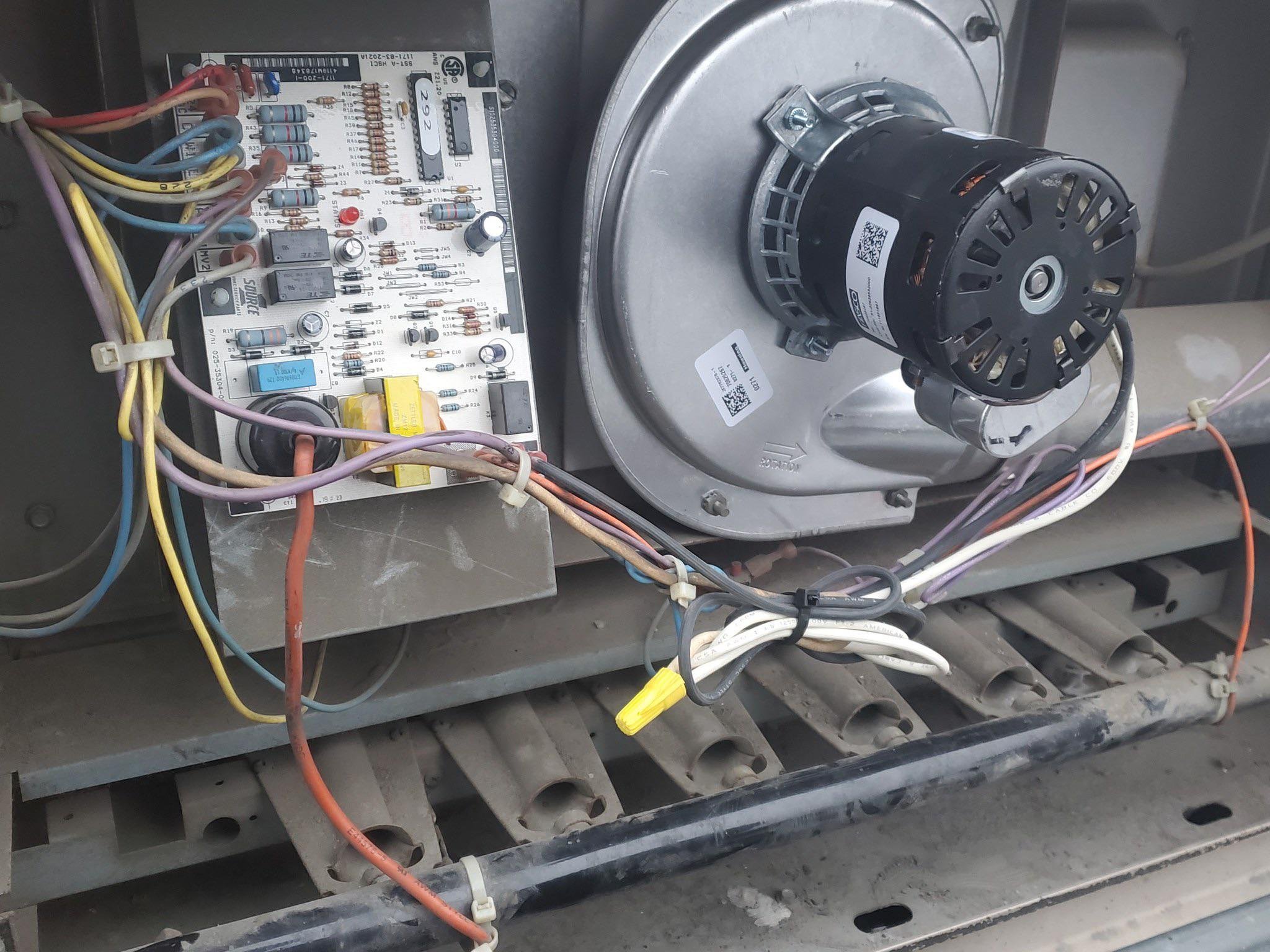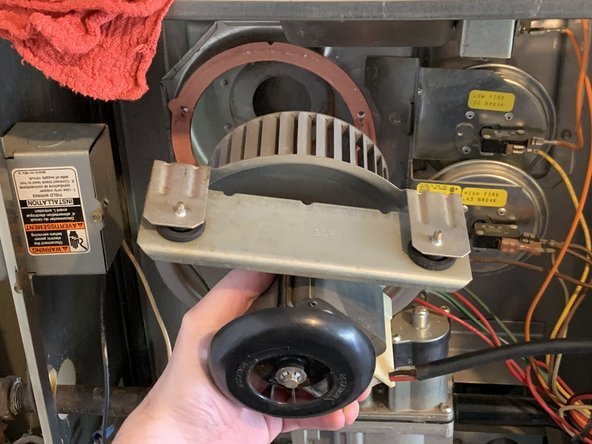The Cost to Replace a Furnace Induction Motor
How much does it cost to replace a furnace induction motor?
PSC Motor Replacement: $400 to $700, including parts and labor.
ECM Motor Replacement: $500 and $1,200, again including parts and labor.
The difference between the PSC and ECM motor is explained below and they are not interchangeable. To find out what type you have, reference your system model number or contact an HVAC professional.
As the heart of your home's heating system, the furnace plays a pivotal role in ensuring comfort during the colder months. Among its various components, the furnace induction motor stands out for its critical function in circulating warm air throughout your home. However, like all mechanical parts, it's susceptible to wear and tear over time. Understanding the costs and considerations involved in replacing a furnace induction motor is essential for any homeowner looking to maintain an efficient and reliable heating system.
The need to replace a furnace induction motor can arise unexpectedly and often leads to urgent questions about the process and costs involved. This article aims to demystify the replacement process, offering a comprehensive guide on the costs, factors influencing these costs, and the steps involved in making an informed decision. Whether you're facing an immediate need for replacement or planning for future maintenance, this guide will provide valuable insights into what to expect when replacing your furnace's induction motor.
In the following sections, we'll delve into what exactly a furnace induction motor is, how to identify when it needs replacing, and a detailed breakdown of the costs involved. By understanding these key aspects, you can make a well-informed decision that balances cost-efficiency with the longevity and reliability of your home's heating system.
What is a Furnace Induction Motor?
A furnace induction motor is a crucial component in your home's heating system. It's responsible for driving the blower or fan, which circulates warm air throughout your home. This motor operates on the principle of electromagnetic induction, hence the name. It's a hardworking part of your furnace, often running for extended periods, especially during cold weather.
There are primarily two types of induction motors used in modern furnaces: Permanent Split Capacitor (PSC) motors and Electronically Commutated Motors (ECM). PSC motors are commonly found in older systems and are known for their simplicity and reliability, but they are less efficient compared to ECMs. ECMs, on the other hand, are more energy-efficient and can adjust their speed to provide better airflow control, making them increasingly popular in newer furnace models.
Understanding the type of motor your furnace uses is important as it impacts both the cost and the process of replacement.
Signs That Your Furnace Induction Motor Needs Replacement
Knowing when to replace your furnace induction motor is key to maintaining an efficient and functional heating system. Here are some common signs that indicate your motor might be nearing the end of its life:
Unusual Noises: A healthy furnace runs relatively quietly. If you start hearing humming, rattling, or screeching sounds from your furnace, it could be a sign of motor bearings wearing out or other mechanical issues within the motor.
Reduced Airflow: If you notice that less air is coming through your vents, or if the air isn't as warm as it used to be, the induction motor could be struggling to operate at full capacity.
Frequent Cycling On and Off: A motor that’s having trouble starting up may cause your furnace to turn on and off more frequently than normal, a process known as short cycling.
The Motor Doesn't Start: In some cases, the motor might fail to start altogether, which is a clear indication that it needs to be looked at by a professional.
Blower Runs Continuously: If your furnace’s blower is running non-stop, it could signal a problem with the motor’s control mechanisms.
Timely attention to these symptoms can prevent more extensive damage to your furnace and avoid the discomfort of a heating system failure, especially during cold weather. It's always recommended to consult with a professional HVAC technician to accurately diagnose the issue before deciding on a replacement.
Factors Influencing the Cost of Replacement
The cost of replacing a furnace induction motor can vary widely, influenced by several key factors:
Motor Type: As mentioned earlier, there are primarily two types of motors – PSC and ECM. ECMs are typically more expensive than PSC motors due to their higher efficiency and advanced technology.
Furnace Model and Brand: The specific model and brand of your furnace can significantly impact the cost. Some brands may have proprietary or specialized motors that are more costly to replace.
Motor Size and Power: Larger homes requiring more powerful motors for adequate heating will face higher costs. The motor’s horsepower and efficiency rating also play a role in determining the price.
Labor Costs: The complexity of the installation process affects labor costs. This can depend on the accessibility of your furnace and the specific requirements of the replacement job.
Geographic Location: Labor and part costs can vary based on where you live. Urban areas or regions with a higher cost of living typically have higher service charges.
Additional Repairs and Maintenance: If your furnace requires other repairs or maintenance work in addition to motor replacement, this will add to the overall cost.
Understanding these factors can help you anticipate the potential costs and make an informed budget for the replacement.
Average Cost of Furnace Induction Motor Replacement
While costs can vary based on the factors mentioned above, here’s a general idea of what you can expect:
PSC Motor Replacement: The cost for a PSC motor replacement typically ranges from $400 to $700, including parts and labor.
ECM Motor Replacement: Replacing an ECM motor can be more expensive, usually between $500 and $1,200, again including parts and labor.
DIY vs. Professional Installation: If you have the necessary skills and tools, doing it yourself can save on labor costs. However, it's important to weigh the risks and potential additional costs if mistakes are made.
Warranty and Service Plans: If your furnace is still under warranty or covered by a service plan, the cost of replacing the motor may be significantly reduced or even covered entirely.
These estimates provide a baseline, but it's crucial to get a specific quote from a professional based on your furnace’s needs. Remember, investing in a high-quality motor and professional installation can save money in the long run through improved efficiency and longevity.
Choosing the Right Replacement Motor
Selecting the appropriate replacement motor for your furnace is crucial for ensuring optimal performance and efficiency. Here are some tips to guide your selection:
Compatibility with Your Furnace: Ensure the motor is compatible with your furnace model. Check the manufacturer's specifications or consult with a professional to find the right fit.
Efficiency Ratings: Consider the efficiency ratings of the motor. An ECM motor, while more expensive upfront, can offer better energy efficiency and lower operating costs in the long run compared to a PSC motor.
Warranty and Brand Reputation: Look for motors with a good warranty period and from reputable manufacturers. A longer warranty can provide peace of mind and potential cost savings if issues arise.
Noise Levels: Some motors are designed to operate more quietly. If noise is a concern, look for motors with lower decibel ratings.
Cost vs. Quality: While it's tempting to choose the cheapest option, balance the initial cost with the motor's quality and expected lifespan. Investing a bit more upfront can lead to long-term savings.
The Replacement Process
Replacing a furnace induction motor involves several steps. While the specifics can vary depending on the furnace model, here’s a general overview:
Safety First: Ensure the furnace is completely turned off and disconnected from the power source.
Access the Motor: Open the furnace panel to access the motor. This may require removing other components.
Disconnect the Motor: Carefully disconnect the motor from the furnace, noting how it's connected to ensure proper reinstallation.
Remove the Motor: Unscrew and remove the motor, taking care not to damage surrounding components.
Install the New Motor: Position the new motor and secure it in place. Reconnect it following the previous configuration.
Test the System: Once installed, reconnect the power and test the furnace to ensure the motor is functioning correctly.
Safety is paramount, and if you are unsure about any step, it's best to consult with or hire a professional.
When to Hire a Professional
While some homeowners may feel comfortable replacing a furnace induction motor themselves, there are situations where hiring a professional is advisable:
Lack of Experience: If you're not confident in your ability to safely complete the job, it's best to hire a professional.
Complex Furnace Models: Some modern furnaces have complex systems that require specialized knowledge for proper maintenance and repair.
Warranty Concerns: DIY repairs might void existing warranties. Check your warranty terms before proceeding.
Safety Concerns: Furnaces involve electrical and mechanical components. If you're not familiar with these systems, professional installation ensures safety.
Time and Tools: If you don't have the necessary tools or time, a professional can complete the job efficiently and correctly.
In the next sections, we'll explore maintenance tips to prolong motor life and wrap up with a conclusion summarizing key takeaways.
Maintenance Tips to Prolong Motor Life
To extend the lifespan of your furnace induction motor and avoid premature replacement, regular maintenance is key. Here are some essential maintenance tips:
Regular Cleaning: Dust and debris can accumulate in and around the motor, leading to overheating and reduced efficiency. Regular cleaning helps maintain optimal performance.
Lubrication: Some motors require periodic lubrication to keep them running smoothly. Check your manufacturer's guide for specific recommendations.
Inspect Belts and Bearings: Worn or damaged belts and bearings can strain the motor. Inspect them regularly and replace them if necessary.
Check Electrical Connections: Loose electrical connections can cause problems. Ensure all connections are secure during routine maintenance.
Regular Professional Inspections: Having a professional HVAC technician inspect your furnace annually can help identify and address small issues before they turn into major problems.
By following these maintenance steps, you can significantly prolong the life of your furnace induction motor and ensure your heating system remains efficient and reliable.
Conclusion
Understanding the cost and process involved in replacing a furnace induction motor is crucial for any homeowner. From recognizing the signs of a failing motor to choosing the right replacement and understanding when professional help is needed, this guide provides a comprehensive look at what to expect. Regular maintenance is the key to prolonging the life of your furnace motor, saving you money and hassle in the long run.
Remember, while DIY replacements can be cost-effective, they are not suitable for everyone. Safety, experience, and warranty considerations should guide your decision. Investing in a quality replacement and professional installation can enhance the efficiency and longevity of your heating system, ensuring your home remains comfortable during the colder months.
We hope this guide has been informative and helps you make well-informed decisions regarding your furnace's maintenance and repair needs.
FAQ Section
Q: How long does an induction motor last?
A: Typically, a furnace induction motor can last between 10-20 years, depending on the model and maintenance.
Q: Can I replace the motor myself?
A: Yes, if you have the necessary skills and tools. However, consider safety, warranty, and the complexity of your furnace before deciding.
Q: Does a more expensive motor mean better quality?
A: Not always, but generally, higher-priced motors offer better efficiency, quieter operation, and longer lifespans.
Q: Should I replace my furnace instead of just the motor?
A: This depends on the age and overall condition of your furnace. If your furnace is near the end of its lifespan, replacing the entire unit might be more cost-effective in the long run.
Q: How can I find a reliable HVAC technician?
A: Look for licensed, insured, and well-reviewed HVAC technicians in your area. Personal recommendations and online reviews can be helpful.




